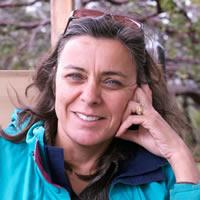
Few scientific disciplines seem to be as diametrically opposite as biology and geology. After all, biology is about life, movement, constant and rapid change; geology deals with dead, virtually unmoving matter that changes over millennia. But that dichotomy disappears the closer you look. Living things can't exist, thrive, and evolve without being affected by their physical environments—and those environments are inevitably changed and transformed by the presence of life. That intersection of geology and biology, the nonliving and the living, is Jillian Banfield's focus. As one of the world's premier researchers in geomicrobiology, she has bridged supposedly disparate scientific disciplines in fresh and exciting ways.
Although geobiology, the study of how living organisms affect the Earth (and vice versa) was recognized as a legitimate field of study as early as the 1930s with the work of Lourens Baas Becking, it attracted little attention and fewer researchers, and was largely considered a fringe subject. By the 1990s, however, new research had helped emphasize the connections between geology and biology, such as how microbial life had affected sedimentary rock structures. Dr. Banfield began her career around this time, and has since become a leading figure in bringing greater recognition and visibility to the field of geobiology. Her research encompasses far-ranging implications for global climate change, environmental science, and even the possible existence of life beyond Earth.
A native Australian, Banfield earned first class honors at Australian National University before coming to America in 1986 for graduate studies at Johns Hopkins in Earth and Planetary Sciences. Her early work involved the use of electron microscopy in mineralogy, but she eventually branched out to explore the intersections of mineralogy with chemistry and biology. She went on to teach at the University of Tokyo and the University of Wisconsin-Madison before coming to the University of California, Berkeley in 2001, where she is now a professor in the Departments of Earth and Planetary Science and Environmental Science, Policy, and Management. She is also a researcher at the Lawrence Berkeley National Laboratory.
At its core, Jillian Banfield's work is about how microorganisms influence their environment—how the chemical and physical activities of life affect its surroundings. Such impact can be far-reaching. For example, microbial activity can lead to an increase or decrease in the amounts of various elements in rock and soil, which can affect the availability of vital minerals, soil formation, rock weathering, and other geological processes. Banfield has demonstrated how and why weathering processes can vary greatly between the controlled environment of the laboratory and nature. She also studies abiotic processes such as the origins of nanoparticles in nature and their effects. Because she frequently studies microbial communities in unusual or extreme environments, her research has both direct and indirect application to astrobiology.
Although her studies employ advanced techniques in electron microscopy and microbiology, she hardly confines her research to the laboratory. Her best known and most cited work came from field study of the microbial community in Iron Mountain, an acid mine drainage site in California. Dr. Banfield and her colleagues applied molecular genomic techniques to produce a detailed analysis of the organisms existing in an extreme and toxic environment so acidic that its waters exceeded the low end of the pH scale. This project not only generated many papers from the research team, but also stimulated a great deal of related work studying various types of microbial communities under different environments.
Apart from her research accomplishments, Banfield has influenced countless students, collaborators, and colleagues, who have been inspired by her work and her example to important achievements of their own. Her work not only continues to inspire fresh insights in geology, microbiology, and environmental science, but may provide the foundation for diverse applications including environmental clean-up and soil contaminant removal, microbial leaching of useful metals from low-grade ores, and even nanotechnology and the control of nanopollutants. A true scientific pioneer, Jillian Banfield is one of the key figures who has brought the formerly "fringe" discipline of geobiology to the forefront of scientific discovery and knowledge.
Information as of April 2011

